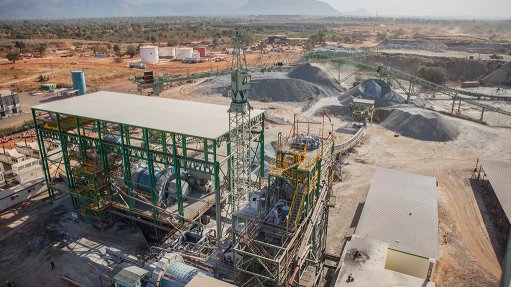
Name: Tabakoto mine.
Location: The Tabakoto mine is located in western Mali, about 360 km west of the capital, Bamako.
Controlling Company: Endeavour Mining owns an 80% interest in the Tabakoto mine through its 100% owned Malian subsidiary, Ségala Mining Corporation.
Brief History: Nevsun Resources placed its Tabakoto mine on care and maintenance in September 2007. In March 2008, Nevsun sold the mine to Avion Gold. Endeavour Mining acquired Avion in 2012 and thereby acquired all operating subsidiaries of Avion, including ownership of the properties that comprise the Tabakoto gold mine and nearby Kofi property.
Brief Description: The Tabakoto deposits are accessed from two portals at the bottom of the Tabakoto openpit. Similarly, the Ségala deposit is accessed by a decline from the Ségala openpit. These openpits ceased mining in 2010 and 2011 respectively. Ségala is ramping up to commercial production.
Underground operations of the Tabakoto and Ségala mines provide the bulk of the ore for the Tabakoto mill as of the second half of 2014. Run-of-mine feed from the Djambaye II openpit and some stockpile material currently provide additional feed to the mill. The Kofi C deposit is being incorporated into the Tabakoto production schedule in 2015 and resources on the Kofi Nord permit continue to be evaluated for possible incorporation into the overall production schedule.
Geology/Mineralisation: The Tabakoto and Kofi properties are located in the eastern part of the Paleoproterozoic Kédougou-Kéniéba inlier. The inlier represents the westernmost exposure of the Birimian Supergroup (2050 to 2200 Ma) of the West African Craton. The Kédougou-Kéniéba inlier is bounded on its western margin by the Hercynian Mauritanide Orogenic belt and is unconformably overlain by flat-lying sandstones of the Paleozoic Taoudeni basin.
The Birimian rocks of the Kédougou-Kéniéba inlier have been subdivided into the western Mako Series (granite/greenstone belt) and the eastern Dialé-Daléma Series. They are separated by the Main Transcurrent Zone (MTZ). The Mako Belt consists of tholeiitic basalt and andesite lavas, with intercalated volcanic agglomerates and banded tuffs that are intruded by a complex sequence of pre- and syntectonic mafic and felsic plutons.
The Dialé-Daléma series comprises marine sedimentary rocks, interbedded locally with calcalkaline ash and lapilli tuffs and intruded by late plutons, dikes and sills of intermediate to felsic compositions.
West of the Senegal-Malian shear zone, Endeavour geologists subdivided the Birimian Supergroup into two parts – the Loulo basin series and the Kofi formation. The Tabakoto and Kofi deposits lie within the Kofi formation.
Mineralisation on the property is structurally controlled. At Tabakoto, the gold mineralisation is mainly associated with zones of fracturing and brecciation within and proximal to the axial zone of the north-trending Tabakoto anticline. The structures are orientated north-west and north-east with steep to vertical dips.
The Ségala deposit consists of a series of parallel mineralised zones along an axial plane of an isoclinal fold that has a fold axis trending to the north-west. The Ségala Main zone consists of a central, wider core of alteration and mineralisation bound to the north and south by several 0.5-m- to 5-m-wide bands of more intense alteration and mineralisation.
Reserves: Proven and probable reserves as at December 31, 2013, were 0.794-million ounces, 60% of which comprise underground reserves at an average grade of 4.1 g/t gold.
Resources: Total measured and indicated resources as at December 31, 2013, were 1.679-million ounces. Inferred resources were 1.603-million ounces.
Products: Gold.
Mining Method: Underground mining of the Tabakoto deposit is conducted by long-hole open stoping and began in early 2012 from two portals at the bottom of the Tabakoto pit.
Underground mining of the Ségala deposit is conducted by transverse long-hole stoping with a cemented rock fill. Initial stope development is currently under way and the mine will be ramping up to commercial production levels in the remainder of 2014.
The mining of the Djambaye II, Dar Salam and Kofi C deposits will use conventional openpit mining methods, with drilling and blasting of competent material followed by load and haul.
Major Infrastructure and Equipment: Ore is processed through a 4 000 t/d plant and gold is recovered through a standard gravity carbon-in-leach process.
Prospects: The Kofi C deposit was recently added to the reserves and production schedule for Tabakoto. A mining permit application was submitted in September 2013 to the Malian government for the Kofi North permit. The application is under review by the Direction Nationale de la Géologie et des Mines, and final approval is expected in mid- to late 2014.
Contact Person: Senior VP business development Doug Reddy.
Contact Details:
Endeavour Mining,
tel +1 604 609 6110,
email info@endeavourmining.com, and
website http://www.endeavourmining.com.